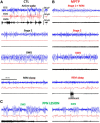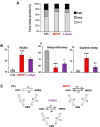Sleep disorders in Parkinsonian macaques: effects of L-dopa treatment and pedunculopontine nucleus lesion
- PMID: 24990932
- PMCID: PMC4078088
- DOI: 10.1523/JNEUROSCI.0181-14.2014
Sleep disorders in Parkinsonian macaques: effects of L-dopa treatment and pedunculopontine nucleus lesion
Abstract
Patients with Parkinson's disease (PD) display significant sleep disturbances and daytime sleepiness. Dopaminergic treatment dramatically improves PD motor symptoms, but its action on sleep remains controversial, suggesting a causal role of nondopaminergic lesions in these symptoms. Because the pedunculopontine nucleus (PPN) regulates sleep and arousal, and in view of the loss of its cholinergic neurons in PD, the PPN could be involved in these sleep disorders. The aims of this study were as follows: (1) to characterize sleep disorders in a monkey model of PD; (2) to investigate whether l-dopa treatment alleviates sleep disorders; and (3) to determine whether a cholinergic PPN lesion would add specific sleep alterations. To this end, long-term continuous electroencephalographic monitoring of vigilance states was performed in macaques, using an implanted miniaturized telemetry device. 1-Methyl-4-phenyl-1,2,3,6-tetrahydropyridine treatment induced sleep disorders that comprised sleep episodes during daytime and sleep fragmentation and a reduction of sleep efficiency at nighttime. It also induced a reduction in time spent in rapid eye movement (REM) sleep and slow-wave sleep and an increase in muscle tone during REM and non-REM sleep episodes and in the number of awakenings and movements. l-Dopa treatment resulted in a partial but significant improvement of almost all sleep parameters. PPN lesion induced a transient decrease in REM sleep and in slow-wave sleep followed by a slight improvement of sleep quality. Our data demonstrate the efficacy of l-dopa treatment in improving sleep disorders in parkinsonian monkeys, and that adding a cholinergic PPN lesion improves sleep quality after transient sleep impairment.
Keywords: Parkinson's disease; cholinergic neurons; l-dopa; macaques; pedunculopontine nucleus; sleep disorders.
Copyright © 2014 the authors 0270-6474/14/349124-10$15.00/0.
Figures






Similar articles
-
Gait disorders in parkinsonian monkeys with pedunculopontine nucleus lesions: a tale of two systems.J Neurosci. 2013 Jul 17;33(29):11986-93. doi: 10.1523/JNEUROSCI.1568-13.2013. J Neurosci. 2013. PMID: 23864685 Free PMC article.
-
Levodopa affects spike and local field synchronisation in the pedunculopontine nucleus of a rat model of Parkinson's disease.Aging (Albany NY). 2021 Feb 26;13(5):7314-7329. doi: 10.18632/aging.202585. Epub 2021 Feb 26. Aging (Albany NY). 2021. PMID: 33639616 Free PMC article.
-
Role of the pedunculopontine nucleus in controlling gait and sleep in normal and parkinsonian monkeys.J Neural Transm (Vienna). 2018 Mar;125(3):471-483. doi: 10.1007/s00702-017-1678-y. Epub 2017 Jan 13. J Neural Transm (Vienna). 2018. PMID: 28084536 Review.
-
Role of pedunculopontine cholinergic neurons in the vulnerability of nigral dopaminergic neurons in Parkinson's disease.Exp Neurol. 2016 Jan;275 Pt 1:209-19. doi: 10.1016/j.expneurol.2015.11.004. Epub 2015 Nov 10. Exp Neurol. 2016. PMID: 26571193
-
Reciprocal interaction between monoaminergic systems and the pedunculopontine nucleus: Implication in the mechanism of L-DOPA.Neurobiol Dis. 2019 Aug;128:9-18. doi: 10.1016/j.nbd.2018.08.014. Epub 2018 Aug 24. Neurobiol Dis. 2019. PMID: 30149181 Review.
Cited by
-
The use of nonhuman primate models to understand processes in Parkinson's disease.J Neural Transm (Vienna). 2018 Mar;125(3):325-335. doi: 10.1007/s00702-017-1715-x. Epub 2017 Mar 29. J Neural Transm (Vienna). 2018. PMID: 28357564 Review.
-
Non-human primate models of PD to test novel therapies.J Neural Transm (Vienna). 2018 Mar;125(3):291-324. doi: 10.1007/s00702-017-1722-y. Epub 2017 Apr 8. J Neural Transm (Vienna). 2018. PMID: 28391443 Review.
-
Chronic sleep deprivation induces plasma exosome-derived miR-150-5p downregulation as a novel mechanism involved in Parkinson's disease progression by targeting DCLK1.J Transl Med. 2025 Jul 11;23(1):781. doi: 10.1186/s12967-025-06801-y. J Transl Med. 2025. PMID: 40646516 Free PMC article.
-
Arousal, motor control, and parkinson's disease.Transl Neurosci. 2015 Oct 5;6(1):198-207. doi: 10.1515/tnsci-2015-0021. eCollection 2015. Transl Neurosci. 2015. PMID: 27747095 Free PMC article. Review.
-
Nigrostriatal Dopamine Acting on Globus Pallidus Regulates Sleep.Cereb Cortex. 2016 Apr;26(4):1430-9. doi: 10.1093/cercor/bhu241. Epub 2014 Oct 14. Cereb Cortex. 2016. PMID: 25316334 Free PMC article.
References
Publication types
MeSH terms
Substances
Grants and funding
LinkOut - more resources
Full Text Sources
Other Literature Sources
